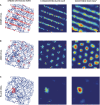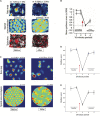A Neural Model of Intrinsic and Extrinsic Hippocampal Theta Rhythms: Anatomy, Neurophysiology, and Function
- PMID: 33994965
- PMCID: PMC8113652
- DOI: 10.3389/fnsys.2021.665052
A Neural Model of Intrinsic and Extrinsic Hippocampal Theta Rhythms: Anatomy, Neurophysiology, and Function
Abstract
This article describes a neural model of the anatomy, neurophysiology, and functions of intrinsic and extrinsic theta rhythms in the brains of multiple species. Topics include how theta rhythms were discovered; how theta rhythms organize brain information processing into temporal series of spatial patterns; how distinct theta rhythms occur within area CA1 of the hippocampus and between the septum and area CA3 of the hippocampus; what functions theta rhythms carry out in different brain regions, notably CA1-supported functions like learning, recognition, and memory that involve visual, cognitive, and emotional processes; how spatial navigation, adaptively timed learning, and category learning interact with hippocampal theta rhythms; how parallel cortical streams through the lateral entorhinal cortex (LEC) and the medial entorhinal cortex (MEC) represent the end-points of the What cortical stream for perception and cognition and the Where cortical stream for spatial representation and action; how the neuromodulator acetylcholine interacts with the septo-hippocampal theta rhythm and modulates category learning; what functions are carried out by other brain rhythms, such as gamma and beta oscillations; and how gamma and beta oscillations interact with theta rhythms. Multiple experimental facts about theta rhythms are unified and functionally explained by this theoretical synthesis.
Keywords: Adaptive Resonance Theory; adaptively timed learning; entorhinal cortex; grid cell; hippocampus; learning; place cell; spatial navigation.
Copyright © 2021 Grossberg.
Conflict of interest statement
The author declares that the research was conducted in the absence of any commercial or financial relationships that could be construed as a potential conflict of interest.
Figures















Similar articles
-
How reduction of theta rhythm by medial septum inactivation may covary with disruption of entorhinal grid cell responses due to reduced cholinergic transmission.Front Neural Circuits. 2013 Oct 31;7:173. doi: 10.3389/fncir.2013.00173. eCollection 2013. Front Neural Circuits. 2013. PMID: 24198762 Free PMC article.
-
A Model of the CA1 Field Rhythms.eNeuro. 2021 Nov 8;8(6):ENEURO.0192-21.2021. doi: 10.1523/ENEURO.0192-21.2021. Print 2021 Nov-Dec. eNeuro. 2021. PMID: 34670820 Free PMC article.
-
Space, time and learning in the hippocampus: how fine spatial and temporal scales are expanded into population codes for behavioral control.Neural Netw. 2007 Mar;20(2):182-93. doi: 10.1016/j.neunet.2006.11.007. Epub 2007 Jan 11. Neural Netw. 2007. PMID: 17222533
-
From brain synapses to systems for learning and memory: Object recognition, spatial navigation, timed conditioning, and movement control.Brain Res. 2015 Sep 24;1621:270-93. doi: 10.1016/j.brainres.2014.11.018. Epub 2014 Nov 20. Brain Res. 2015. PMID: 25446436 Review.
-
Theta Oscillations Through Hippocampal/Prefrontal Pathway: Importance in Cognitive Performances.Brain Connect. 2020 May;10(4):157-169. doi: 10.1089/brain.2019.0733. Epub 2020 May 7. Brain Connect. 2020. PMID: 32264690 Review.
Cited by
-
Role and mechanisms of interneurons in chronic pain and pain-induced cognitive impairment.Zhong Nan Da Xue Xue Bao Yi Xue Ban. 2025 Apr 28;50(4):625-630. doi: 10.11817/j.issn.1672-7347.2025.240402. Zhong Nan Da Xue Xue Bao Yi Xue Ban. 2025. PMID: 40785676 Free PMC article. Review. Chinese, English.
References
Publication types
LinkOut - more resources
Full Text Sources
Other Literature Sources
Miscellaneous

